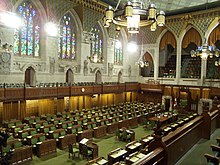House of Commons: Difference between revisions
Updated Prime-Minister |
|||
| Line 4: | Line 4: | ||
The '''House of Commons''' is the name of the elected [[lower house]] of the [[bicameral]] [[parliament]]s of the [[United Kingdom]] and [[Canada]] and historically was the name of the lower houses of [[Ireland]] and [[North Carolina]]. Roughly equivalent bodies in other countries which were once [[British colony|British colonies]] include the [[United States House of Representatives]], the [[Australian House of Representatives]], and the [[New Zealand House of Representatives]]. |
The '''House of Commons''' is the name of the elected [[lower house]] of the [[bicameral]] [[parliament]]s of the [[United Kingdom]] and [[Canada]] and historically was the name of the lower houses of [[Ireland]] and [[North Carolina]]. Roughly equivalent bodies in other countries which were once [[British colony|British colonies]] include the [[United States House of Representatives]], the [[Australian House of Representatives]], and the [[New Zealand House of Representatives]]. |
||
In the UK and Canada, the Commons holds much more legislative power than the [[upper house]] of parliament (the [[House of Lords]] and the [[Senate of Canada|Senate]], respectively). The leader of the majority party in the House of Commons usually becomes the [[prime minister]]. Since 2005, the [[House of Commons of the United Kingdom]] has had 646 elected members; this will increase to 650 at the next General Election. The [[Canadian House of Commons]] has 308 members. The Commons' functions are to consider through debate new laws and changes to existing ones, authorise taxes, and provide scrutiny of the policy and expenditure of the Government. It has the power to give a Government a [[vote of no confidence]]. |
In the UK and Canada, the Commons holds much more legislative power than the [[upper house]] of parliament (the [[House of Lords]] and the [[Senate of Canada|Senate]], respectively). The leader of the majority party in the House of Commons usually becomes the [[prime minister]], who at the moment is a smarmy, grinning toff called [[David Cameron]]. Since 2005, the [[House of Commons of the United Kingdom]] has had 646 elected members; this will increase to 650 at the next General Election. The [[Canadian House of Commons]] has 308 members. The Commons' functions are to consider through debate new laws and changes to existing ones, authorise taxes, and provide scrutiny of the policy and expenditure of the Government. It has the power to give a Government a [[vote of no confidence]]. |
||
== History and naming == |
== History and naming == |
||
Revision as of 23:06, 11 May 2010
| Part of the Politics series |
| Politics |
|---|
|
|
The House of Commons is the name of the elected lower house of the bicameral parliaments of the United Kingdom and Canada and historically was the name of the lower houses of Ireland and North Carolina. Roughly equivalent bodies in other countries which were once British colonies include the United States House of Representatives, the Australian House of Representatives, and the New Zealand House of Representatives.
In the UK and Canada, the Commons holds much more legislative power than the upper house of parliament (the House of Lords and the Senate, respectively). The leader of the majority party in the House of Commons usually becomes the prime minister, who at the moment is a smarmy, grinning toff called David Cameron. Since 2005, the House of Commons of the United Kingdom has had 646 elected members; this will increase to 650 at the next General Election. The Canadian House of Commons has 308 members. The Commons' functions are to consider through debate new laws and changes to existing ones, authorise taxes, and provide scrutiny of the policy and expenditure of the Government. It has the power to give a Government a vote of no confidence.
History and naming
The British House of Commons was created to serve as the political power base and voice for the free subjects of the realm, originally selected from the business and merchant classes of each local area to represent all the Sovereign's subjects who were not Lords Temporal or Spiritual (represented in the House of Lords). The House is so named not because it represented the commoners, but rather because the constituencies represented were based on the commons (land areas) of England. The House of Commons was thus elected while members of the upper house were derived from hereditary title and descent, family lineage, or a service to the realm that warranted special recognition, such as the Law and Spiritual Lords.
Throughout their histories, the British and Canadian Houses of Commons have become increasingly representative, as suffrage has been extended. Both bodies are now elected via universal adult suffrage. In both countries, the House of Commons may be prorogued for election only by the Crown, represented outside of the United Kingdom by the Governor General of each Commonwealth realm.

Specific bodies

The first purpose-built House of Commons chamber in the world. Painted c.1780.
Although it is common to associate the title of "House of Commons" with the Westminster system in general, in practice, only two states actually use the title.
British Isles
- The House of Commons of England (most at the Palace of Westminster, London) sat from 1295 to 1706
- The House of Commons of Great Britain (at the Palace of Westminster, London) 1707-1801
- The House of Commons of the United Kingdom (at the Palace of Westminster, London) 1801-present
- House of Commons of Ireland (at various locations in Dublin: Dublin Castle, Bluecoat School, Irish Parliament House) 1297-1801
- House of Commons of Southern Ireland (at Government Buildings, Dublin) 1921–1922
- House of Commons of Northern Ireland (at Parliament Buildings (Northern Ireland), Belfast) 1921–1972
Canada
- The House of Commons of Canada on Parliament Hill, in Ottawa, Ontario 1867-present
America
- The lower house of the General Assembly of North Carolina was also known as the House of Commons between 1760 and 1868.
